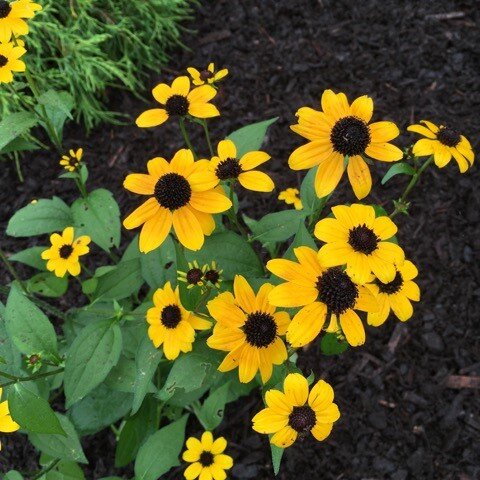Pollinator gardens are increasing in popularity due to scientific evidence that pollinator populations are declining. Our collective efforts matter; the smallest balcony garden can benefit pollinators more than the largest garden if it is designed with their needs in mind. And while cities don’t necessarily support more bees, they do seem to support a greater diversity of bees making urban environments key in conservation efforts.
Like all living things, pollinators need food, water and shelter. Nectar provides both food and moisture, making plants with nectar of great benefit to bees and adult butterflies. Trees are important as are flowering perennials for their ongoing contribution to supplying food for pollinators.
Designing pollinator-friendly gardens is a pleasure for us and for conscientious homeowners who want to support these important, tiny insects. We use a mix of native and non-native plants that keep gardens buzzing and beautiful all summer…here’s some of our favorites.
Amy's favorite black-eyed Susan is Rudbeckia tribola ‘Blackjack Gold’. These long lasting miniature flowers have dark black button centers for lovely contrast.
Black-Eyed Susan
Rudbeckia hirta is a bright yellow daisy-like flower with dark center cones from which they get their common name. There are a number of varieties to chose from as well as both annual and perennial types.
One of the most popular perennial varieties is Rudbeckia fulgida ‘Goldstrum’ which can be seem blooming like crazy for weeks each season. Golden yellow, daisy-like petals surround nectar-rich dark cones on stems that reach up to 3’ tall. They are very easy to grow, deer resistant and tolerate most pests, soils and moisture levels.
Black-eyed Susan is a butterfly magnet since these flying beauties love bright orange, yellow and red flowers. While bees are better pollinators, butterflies are a welcome addition to the garden…and the perennial black-eyed Susan will attract both.
Chelone lynoii ‘Hot Lips’ turtlehead in Colleen’s garden…bees love crawling inside to gather pollen.
Turtlehead
Chelone lynoii ‘Hot Lips’ is a long blooming herbaceous perennial that grows to 2-4 feet high and a bit narrow in width. This variety of turtlehead is rose pink in colour and we like it because it is hardy to zone 3, performs well in sun or part shade, blooms from July to September and deer generally leave it alone. This reliable and easy to grow plant attracts both bees and butterflies.
There is a native white variety as well ‘Chelone Clabra’ that can be found in wet locations in the wild and adapts well to average garden soils. It is one of two larval food plants for the orange and brown Baltimore Checker Spot butterfly which can be found in Nova Scotia as far north as Baddeck on Cape Breton Island.
Bees remove the flowers from Colleen’s Veronica each year. These towering 4-5 foot plants are topped by flowering spikes which are are completely bare within days of blooming. Colleen harvests the dried plants in fall for indoor flower arrangements.
Veronica
Veronica or Speedwell or as they are sometimes called, are full- to part-sun perennial available in a variety of heights and bloom colors. These long-blooming and (sometimes) low care perennials are loved for their distinctive vertical lines and spiky flowers in the garden landscape.
Slender upright blooms in white, blue, pink, purple or violet attract butterflies and bees alike. Some varieties can be encouraged to re-bloom by removing spent flowers.
Graceful and showy, these popular plants are lovely in city and courtyard gardens, rock gardens or informal cottage landscapes.
Check tags to be sure you pick compact, non-invasive varieties such as ‘White Wands’. Veronica perennials are easy to grow, low maintenance (depending on the variety) and generally disease free although some are a bit susceptible to mildew.
Photo Credit: Linnaea Mallette; www.needpix.com
Aster
Asters are one of the most important fall nectar plants, providing end of season food when many flowering perennials are done for the year. A number of asters are also important food plants for butterfly larvae and local crescent butterflies feed on them.
New England Aster (Aster novae-angliae) is native to Nova Scotia and one of the largest and showiest of the larger aster varieties. Growing from 2-6 feet tall, these lovely fall blooming perennials produce lovely violet, purple or rose blooms.
Asters are fairly easy to grow from seed and readily available potted up for planting from Nova Scotia nurseries in mid- to late-summer.
Asclepia incarnate blooms in Margaret Baillys’ Halifax garden.
Photo Credit: Margaret Bailly; BFA, Environmental Horticulturalist
Milkweed
A recent trend to protect monarch butterflies has resulted in the planting of tropical milkweed in Canadian gardens. Asclepias curassavia can harm monarchs by confusing their migration (unless planted in the Caribbean of course).
There are 12 native milkweeds in Canada. In eastern Canada, you should seek out eastern strains such as common milkweed, Asclepia syriaca; butterflyweed, Ascelpia tuberosa; or swamp milkweed, Asclepia incarnate. The latter variety is one of the widest ranging and showiest types of milkweed with brightly coloured white and pink blooms at the tips of 2-4 foot stems.
If you want to attract monarchs, check local nurseries for native milkweed plants. Milkweed can become invasive making it less “low maintenance” than other plants we have included. So, plant milkweed accordingly and remember that is is a source of food so expect to see caterpillars on your plants.
A new planting of ‘Denim and Lace’ Russian sage paired with PowWow coneflower, porcupine grass and bright golden barberry shrubs in a downtown Halifax garden.
Russian Sage
We love Russian sage for its grey-green leaves on silver white stems and haze of purple flowers. This is a woody perennial that offers year round interest. It performs best in full sun to produce long lasting blooms from mid summer to early fall.
Perovskia atrciplicifolia can reach 3 feet or higher with a slightly narrower spread. We like it for its tall airy wands of color, easy grow qualities and drought tolerance in sunny locations. It attracts bees, butterflies and hummingbirds…and is not appealing to deer making it an excellent choice for gardens frequented by wildlife. It is stunning with ornamental grasses and other pollinator attracting plants in a mixed perennial garden.
There are a number of varieties that suit smaller urban gardens including ‘Little Spire’ which reaches a tidy 18 to 24 inches tall and wide and ‘Blue Spire’ that grows more upright stems of 24 to 36 inches tall and wide.
Allium ‘Millenium’ blooms catch the breeze and cast a playful shadow on a rock feature in a Halifax garden.
Ornamental Onion
Allium ‘Millenium’ is a bulb plant that we often find in nurseries planted up and ready to put in the garden; handy so we don’t need to wait till fall to plant bulbs. Unlike many ornamental alliums, this hybrid forms a nice tidy clump with flower heads that contain seed capsules…they will self seed if you don’t dead-head after flowering.
The foliage of this plant reaches about 6-12” with a rose-purple blooms on top of a 18” scape in mid summer. It’s showy flowers attract butterflies but the onion scent is a deterrent to deer making it a good plant for many gardeners. Although the plant has an onion smell, it is an ornamental and is not to be used for culinary purposes.
‘Millenium” likes full sun although in very hot summer climates it likes a bit of afternoon shade. It tolerates a wide range of soils and in very moist conditions bulbs may rot. Overall, this is an easy to grow, striking accent plant for borders and cottage gardens.
Echinacea purpurea ‘PowWow Wild Berry’.
Coneflower
Echinacea purpurea is a native perennial commonly known as purple coneflower. This is a beautiful and hardy plant native to eastern North America. It’s large, purple, cone-shaped blossoms attract bees and butterflies and song birds love the small seeds produced in the fall. It matures at 2-4’ in height and can be left standing over the winter as the spent flower stems will remain erect well into winter. Multi-functional, this plant is not only a lovely addition to the garden, it’s third year roots are used medicinally as an immune booster.
Coneflower comes in many varieties and colours include white, green and shades of pink. It is an excellent long-blooming flower and lovely when planted massed with black-eyed Susans.
Echinacea purpurea ‘PowWow Wild Berry’ is a favored variety for its shorter height and deep purple-pink to magenta flowers that hold their color very well as they age in the garden landscape. More branches means more blooms per plant for a showier display. They will keep blooming without being deadheaded although pruning will keep them looking tidy.









